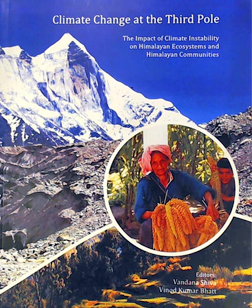ASHOK B SHARMA
http://www.ehitavada.com/News_Paper_Images/2013/04/28/news_images/news_219650.jpg
http://www.millenniumpost.in/NewsContent.aspx?NID=26663
http://news.anypursuit.org/tiki-read_article.php?articleId=24198
It is a paradoxical situation where the government is gearing up to pilot the Food Security Bill in the Parliament, it is engaged in grabbing prime farmland and gifting it to corporate houses for reaping super profits.
The UPA government’s much touted programme for rendering food security has turned out to be a hoax. Its deliberate intention of alienating farmers from their source of livelihood stands exposed. According to official records the country has already lost 4,91,000 hectare farmland in 2006-11. The farm growth has plateaued and the rate of population growth is not yet contained. With the continual shrinkage of farmland, the country will be headed for the problem of feeding millions of hungry mouths. The ultimate resort will be to import food at higher global prices.
The aggressiveness in which the government is pushing the Land Acquisition, Rehabilitation and Resettlement Bill, 2011 shows that it is neither concerned about the nation’s food security nor the livelihood of farmers.
The old Land Acquisition Act, 1894 has clearly defined that the farmland should be acquired for public purpose particularly for defence, railways, irrigation and for setting up of educational institutions, hospitals by the government. But the new Bill has sought to redefine the concept of “public purpose” by recognising the activities of public-private partnership projects and “private companies for public purpose.”
Now public purpose includes infrastructure projects, all activities or items listed in the notification of the government in the Department of Economic Affairs – Infrastructure section vide March 27, 2012 excluding private hospitals, private educational institutions and private hotels. However apart from necessary industrial corridors or mining activities, healthcare, transportation, the Bill allows setting up of manufacturing zones as designated in the national manufacturing policy, projects for sports, tourism, transportation or space programme
The Bill mentions some proposed farm related activities on acquired land but failed to restrict it only for activities by farmers or farmers’ cooperatives. It said that these activities can be taken up by the government or “by an institution set up under a statute”, thus paving the way for private sector involvement.
Farmers should also be permitted to do the same activities of development on their own lands on payment of external development charges as permitted to builders by the authority.
There had been a series of agitations in the past by farmers when the government launched the scheme of Special Economic Zones (SEZs). Prime farmlands were grabbed in many places for setting up of SEZs. Till date 389 SEZs have been notified of which 170 are functional.
The government has now realised that these SEZs were set up on lands in excess of their actual requirement. The Commerce and Industry Minister Anand Sharma has admitted the folly committed by his predecessor Kamal Nath. He has scaled down the minimum requirement for a multi-product SEZ from 1000 hectare to 500 hectare and for a sector-specific SEZ from existing 100 hectare to 50 hectare. For IT and ITES SEZs the minimum 10 hectare land area has been done away with. Now there would be no minimum land requirement for setting up an IT/ITES SEZ, but only the minimum built up area criteria would be required to be met.
This measure of scaling down of land requirement has been done to enable the SEZs to be eligible for duty benefits. The Commerce Minister has done his best to bail out the SEZs. But has not thought of how the excess land lying vacant would be utilised. He should have thought of returning these excess land to agriculture.
It is high time that the government come out with a National Land Use Plan and have a fresh look at categorisation of land on basis of this Plan. India should learn from Brazil which has brought large chunks of non-farm land into agriculture.
But the Bill when first introduced in the Parliament said that compensation to be paid in rural areas will be double the market value which is referred to as Indian Stamp Duty and for urban areas it will be equal to the Indian Stamp Duty plus solatium in both the cases equivalent to 100% of the market value.
The date for determination of market value shall be the date on which the notification has been issued under section 11.
Further amendments has been proposed reducing the compensation amount in rural areas, under the pretext of its proximity to urban area.
The amendments proposed in the Bill has given full powers to the District Collector to acquire land with a view to hasten the process of land transfer and without entertaining resentments from unwilling farmers. Earlier it was proposed in the original Bill that a committee be set up to examine the proposal for acquiring more than 100 acre land. The Committee will be headed chief secretary and consist of secretaries of finance, revenue, rural development, social justice, tribal welfare, panchayati raj and concerned departments as may be specified by the State Government and three non-official experts from the relevant fields.
But in the amendments the proposal for setting up a committee has been done away with and all powers are vested in the District Collector.
“Provided that in respect of a public purpose in a District for an area not exceeding such as may be notified by the appropriate Government, the Collector of such District shall be deemed to be the appropriate Government,” the amendment proposed to the Bill said,
As per precedence and conventions if the Government proposes 150 amendments then the Bill should be again referred to the Parliamentary Standing Committee or a Select Committee or a Joint Committee. Here the Government has proposed 154 amendments changing the character of the Bill.
In the amendments to the Bill only 20% of the developed land has been offered to the farmers in lieu of compensation while the UP Government in its land acquisition policy of 2011 had offered 23% of developed land which the farmers refused to accept.
Section 28A of the old Act provided for benefits to all affected families of the enhanced compensation awarded by the Court to one individual. There is no such provision in the current Bill. One should have a similar section in the new law too.
In Chapter XI of the Bill - Temporary Occupation of Land - should be deleted as it s allows Government to acquire land for a company against farmers wishes. Companies are likely to misuse the powers given under this section, as they will first take land on a temporary basis, and when it becomes totally unfit for cultivation then ask the Collector to acquire it permanently. No arbitrary powers should be given to the District Collector.
The Bill draws differentiates land acquisition in non-scheduled areas and scheduled areas. It says as far as possible, no acquisition of land shall be made on the Scheduled Areas. Where such acquisition does take place it shall be done only as a demonstrable last resort. It further says that any land acquisition is to take place in the Scheduled Areas, the prior consent of the concerned Gram Sabha or the Panchayats or the autonomous District Councils, by resolution, at the appropriate level in Scheduled Areas shall be obtained. Most of the farmers in non-scheduled areas have small and medium sized holdings and are dependent on agriculture for their livelihood. Farmers in non-scheduled areas need the similar treatment at par with their tribal brethren in scheduled areas. The mechanism for land acquisition should be the same across the country.
Apart from several controversies, the Bill no way is likely to benefit the farmers and would spell a danger to food security by encouraging grabbing of prime farmland.


















